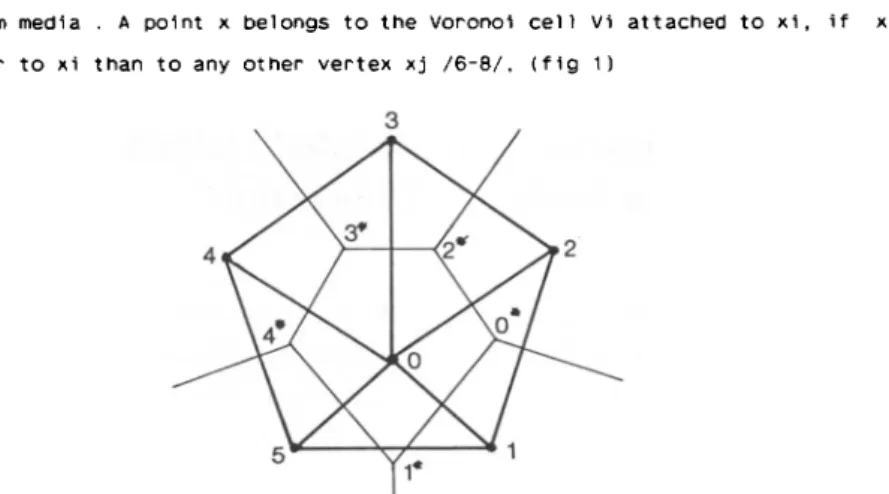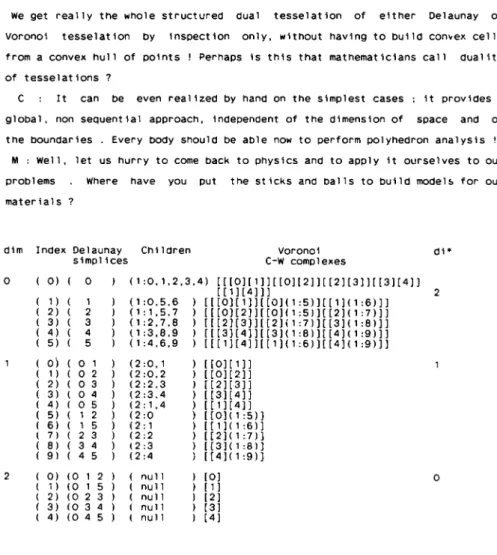-A New
Realization
of the Global
Delaunay-Voronoi
Tesselation
in
Arbitrary
Dimension*
R.
R1edinger1!
,M. Habar!,
P.Oelhafen1
and H.J. Guntherodt'.' Institut
für
Physik,Universitat Basel. Klingelbergstrasse 82, CH 4056 BASEL.
1 Lab.űe Physique et de Spectroscopie Electronique.
Université
de Haute Alsace.F 68093 MULHOUSE CEDEX
.
The dual Delaunay-Voronoi tesselations provide an
unambiguous
description of thetopologica! structure of random media and a covering of space around the
generating points. Numerous algorithms have been proposed for the voronoi
tesselation and more recently, for the dual Delaunay one
.
We present a
property characterizing simplices of all intermediate dimension
constituting
Delaunay cells which allows the full construction of the Delaunay tesseiation,by
recurrence over the dimension of the space
.
We derive by duality, without
calculation, the full dual Voronoi tesselation from a tree of parentship over
the Delaunay tiles, which may be restricted to adjacent dimensions .
The paper is presented as a dialog, in the style of Hume-Rothery's book /I/
.
Candide, a newcomer in the field of liquid and amorphous materials .discusses
with his host Mentor
.
C : You suggested me to examine several works /2-5/
.
I am puzzled by the fact
that if one wants to characterize the state of order of the matter beyond the
pair correlation function, the dual tesselations of Voronoi and Delaunay seem to
be the best tools available ;wy a limited number of
physicists only
is able toperform
this analysis ?M : It is true that the definition of the two tesselations is
quite
simple, buttheir
general
and effective construction is up to now hard to realize. A
Voronoi cell is a convex
polyhedron,
thegeneralization
of aWigner-Seitz
cell*
Presented
atthe
Sixth International Conference
onLiquid
and
Amorphous
Metals,
to random media
.
A point belongs to the Voronoi cell Vi attached to xi, if
is closer to xi than to any other vertex xj /6-8/,
(fig
1)3
Fig 1 : A set of "random points (labelled 0-5) is the squeleton of the Delaunay
tiling (thick line) ; the dual Voronoi
tiling
is represented in thin linesLabels for all elements can be found in table 1
.
C I prefer to some extend the dual Delaunay tesselation /9/. because the
cells are simpler than in the Voronoi one : triangles, tetrahedra in dim. 2 and
3 resp.; one might describe them by a set of (d+1) points in a d-dim. space (a
simplex), (il i2 id+l), which one might even order
lexicographically
11 < i2 <...< id+1 .
I find the property that characterizes a Delaunay tile nice :
There falls no other vertex but the generating ones, inside the circumsphere
to a tile ; furthermore, the center of this sphere is the corresponding dual
Voronoi vertex /6/
.
I just generalized it for regular sub-tiles of lower dimension of the Delaunay
tesselation /10/ :
if no other
point
falls into the d-dim. circumsphere to a di-dimsimplex
0 4 di * d , this simplex
belongs
to theDelaunay
tesselationThis allows to build the
Delaunay
tesseiation,by recurrence over the dimension,by adjoining a further point to an existing tile and checking its
regularity
(fig
2).
M : It seems to me that you miss some segments in this construction ; for
instance.(1
5)
does notverify
yourregularity
criterion .C :
(1 5)
is indeed irregular ; but I obtain it as a part of ahigher
dim. tile(0 15). One has to be patient, and to perform a downward recurrence over
dimension to complete the list of tiles
00
a
t)-Fig
2 : a) A regular 111e (1:0) ; t>) a non regular tile (1:6) ; c) (1:6) .alias(1 .5)
belongs
to the (2:1) tile obtained from (1:0) byadjoi
ing
(5) .Note that
the center of the circumsphere is
[1]
.
M : We get indeed a whole hierarchy of tiles, ordered over dimension and inside
each dimension
.
(di:i) designates a unique tile
.
We report them in table 2
.
One is tempted to
glue
the constituting pieces together, to precise thestructure ; for this, we can define a tree of children :
(d1+1:j)
is a son of (di:i) if(di:i)
Is contained 1n it There exists also atree of parents ! But let us complete table 1 by the children
.
C : At the end of our Delaunay construction, we obtained the Voronoi dual
vertex of each simplex (di:i). as the center of the circumsphere
.
I label
these points as (d:i)* =
[0:i]
=[1]
= 1*.
How could one obtain the whole
Voronoi tessei ation now ?
M : It is well known that the dual
[1:1]
to the hyperplanecontaining
(d-1:i)is trie segment bounded by the Voronoi vertices of cells twinned by this face
But these points are related to the sons of
(d-1:1)
.
How could we precise and
generalize
this property ?C : It seems first that
duality
makes correspond elements ofcomplementary
dimension in each tesse lat ion :
(di:i) <->
[d-dl
:i]
Then, we may describe a Voronoi tile through its boundary
[di
:i]
=[ [di-1
:i1]
...
[di-1 :ij] ]
This means that
[di:i]
is the convex cell bounded by[d1-1:11]
.... Such a description exists in
Rodgers
/11/.
The dual of
[di
:1]
is (d-di:i) : wetake its sons.
(d-d1*1
:11)...(d-dl+1:1J),
and dual back !So, we can build all dual elements by recurrence over the dimension also, and
complete table 2
upwards
.
M : We have just a
problem
with theunpaired
outer cells at the boundary, like[1:5]
; it may beeasily
overcomed byspecifying
that[1:5]
Is the outwardhalf-line
originating
from[0:0] orthogonal
to(1:5)
We get really the whole structured dual tesselation of either Delaunay or
Voronoi tesselation by inspection
only,
without having to build convex cellsfrom a convex hull of points ! Perhaps is this that mathematicians call
duality
of tesselations ?
C It can be even realized by hand on the simplest cases ; it provides a
global,
non sequential approach, independent of the dimension of space and ofthe boundaries
.
Every body should be able now to perform polyhedron
analysis
! M : Well, let us hurry to come back to physics and toapply
it ourselves to ourproblems Where have you put the sticks and balls to build models for our
materials ?
dim Index
Delaunay
simplices Chi1dren Voronoi C-W complexes di< ( 0) ( 0 ) (1:0,1,2,3,4)
[[[0][1]][[0][2]][[2][3]J[[3][4]]
0 0 0 0 ( 4) ( 0 ( 5) ( 1 1 2 3 4( 0)
(0 1 2 ( 1) (0 1 5 ( 2) (0 2 3 ( 3) (0 3 4 ( 4) (0 4 5 :0,5.6 :1.5,7 :2.7,8 :3,8.9 :4,6.9 (2:0,1 (2:0.2 (2:2.3 (2:3,4 (2:1,4(2:0
(2:1
(2:2 ( 2:3(2:4
( nul ( nul ( nul ( nul ( nul[t1][4]]]
[[0][1]]It0](1
[[0][2]][[0](1
tt2][3]][[2](1
[[3][4]][[3](1
1[1][4]][[1](1
[0][1]]
[0][2]]
[2][3]]
[3][4]]
[1][4]]
[0](1
[
1]
(
1[2](
1 [3](1[4](1
0] 1] 2] 3] 4]5)
]
6)] 7)]
8)]
9)]
5)][[1](1
5)][[2](1
7)][[3](1
B)][[4](1
6)][[4](1
6)] 7)] 8»] 9 ))
9I]Table I: Delaunay tesseiatIon,(col.1,2,3) is realized by a recurrence upwards
over the dimension, then downwards to obtain the non
regular
tiles. Dual
Voronoi vertices are obtained at this stage The children are build
by
inspection
.
The Voronoi cells are then built upwards
.
The index is shared by
both tesseiations
.
Acknowledgments.
R. Riedinger whishes to thank to his
colleagues
at Basel for theirfriendly
hospitality.
References
/1/W. Hume-Rotnery , "An introduction to metallurgy", London.Institute
of Metal,
/2/Ed.
F. Yonezawa and T.Ninomiya. "Topological
disorder in condensed matter", Berlin,Springer,
1983.
/3/ R. Collins, in "Phase transitions and critical phenomena" vol 2 ed C. Domb
and M.S. Green. New-York,Academic press,1972, ch 7 271-303
.
/4/T.
Ogawa,
M. Tanemura,Progr.
Theor.Phys.
51,399(1982)
/5/D.R.
Nelson,Phys.Rev.
B28.5515 (1985)/6/ J.L. Finney, Journ.of
Computai.Physics
32,137 (1979)/7/ W. Borstow.J.P. Dussault and B.L. Fox. J.of
Computai. Phys.2.819
(1978) /8/ ü.M.Augenbaum
and CS. Peskin, J.ofComputat. Phys.59,
177(
1985) /4/T.Ogawa,
M. Tanemura,Progr.
Theor.Phys. 51,399 (1982)
/9/ M.

